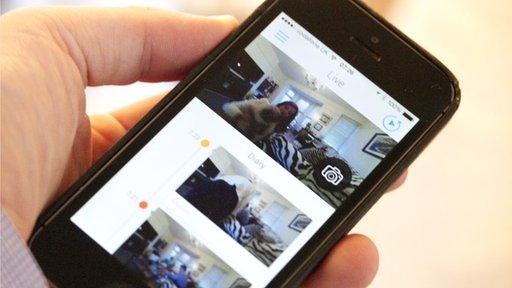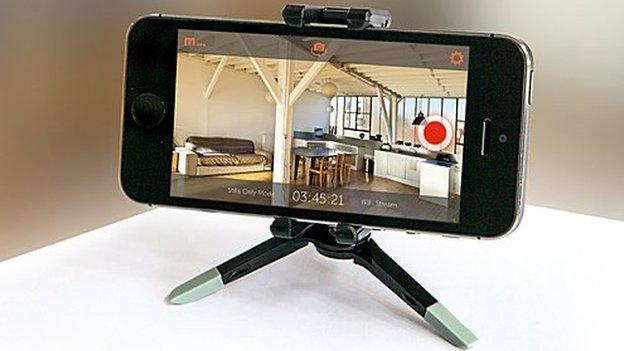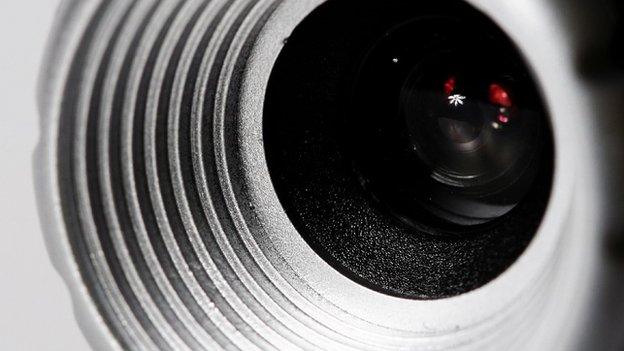Living-room watch: Home cam tracks fiancee and cat
- Published

The Withings Home camera has a wood-effect case to help make it unobtrusive
It seems almost perverse.
At a time when the spread of surveillance tech is stoking controversy, I decided to install an app-controlled internet camera in my flat.
The gadget allowed me to look and listen in to my fiancee and pet cat's living-room activities at any time, and would send me an alert if it detected movement or noise I might be interested in.
A night-vision mode meant the dark offered no respite, and just in case I missed anything there was also the opportunity to review and download a time-lapse clip of recent events.
Paula, my partner, was rather uneasy about the development.
"It's the devil's work," she declared on being introduced to the kit.
"I don't like this, I feel like I'm on Big Brother. I can't pick my nose any more."
Turning off the lights does not hide you from the Withings Home's gaze
Explaining the experiment to others also raised issues.
My brother asked if we were indulging in some twisted Pornhub fantasy, and even my tech-savvy work colleagues struggled to see the appeal.
But I was curious: would getting increased access to Paula and Miggy's private lives over a two-week period make us closer, or just prove a creep-out?
Wedding dress
Things did not get off to an auspicious start.
The unit I was testing - the Withings Home - is deliberately designed to blend in, meaning it is easy to forget it is there.
This almost caused a prenuptial catastrophe.
On the first morning of our experiment, I was woken by a notification that prompted me to watch a brief video of an activity the camera had just captured.

The Withings app sends a notification whenever it hears a sound or detects movement
It showed Paula unpacking her wedding dress for a quick twirl while she thought I was still dozing.
Luck alone meant the clip cut out before the bridal gown swung into full view.
After revealing this, my Brazilian partner became hugely self-conscious of the lounge-based "intruder". Over the course of the rest of the weekend, she made and received calls to her family in other rooms of the flat even though I do not speak Portuguese, so would not benefit from listening in.
What surprised me was how briefly this transition period lasted before her behaviour returned to normal.
A few ground rules probably helped.
Top of the list: no lurking in a remote location without revealing that I was connected.
This was relatively easy to achieve because I could talk through the camera's on-board speaker via an associated tablet and smartphone app to flag my presence.
Pangs of conscience
It also helped that it soon became clear the main attraction, for both Paula and me, was watching our housebound pet - both via a high-definition live stream and a compressed recap of his activities at the end of the day.
Four days of Miggy lounging about on the sofa
Logging in for feline feeds, it turns out, is not only addictive but feels substantially less shameful than doing the same to a human.
But that is not to say it was a guilt-free experience.
In my imagination, during our long hours away from home, Miggy would stroll round the flat, play with his toys, scratch his post and generally engage in an elaborate domestic exercise programme.
What we discovered was that after staring at the window for a few minutes to see if we would return, he would slump on to the sofa and remain there for 15 hours or more.
Helpful neighbours
As a result I now make more of a fuss of him when we are in.
But the discovery that he lets out three short, sharp, cute mews when he hears us at the front door hardly makes up for the fact I am now struck by pangs of conscience every time I go out.
There were benefits to the system.
Discovering that Paula had held up an "I love you" sign to the camera while I was at the gym was particularly heart-warming.
Paula sends a "text message" via the home cam
The camera also proved useful when we went away for a long weekend and could see that our neighbours had repeatedly popped in to keep Miggy company, although in retrospect we should have warned them of the gadget's existence in advance.
But there was more than a modicum of relief when I unplugged the camera and put it away for the last time.
Face the wall
The Home, and competing devices including Google's Dropcam, Netatmo's Welcome and Xiaomi's Yi Smart, are marketed as ways to help parents keep an eye on their children, and families as a whole capture memories that would otherwise be lost.
The companies also suggest that owning such kit acts as a deterrent to thieves whose images would be stored online, even if they took the cameras as part of their haul.

An increasing number of home cams are being released, with features including facial recognition and automatic uploads to the cloud
When I quizzed Withings' brand manager Lucie Broto about her product, she suggested that even pets could benefit. She suggested speaking to my cat while I was out to entertain him.
I suspect my disembodied voice would be more likely to freak him out.
More telling was her revelation, when pressed, that her boyfriend often turns their copy of the Home to face the wall or even unplugs it when he is at home alone in their Paris apartment.
'Jealous boyfriends'
After a fortnight of being put under the internet's equivalent of the microscope, the last word deservedly goes to Paula: "These things need to have a purpose. For security you could set up an alarm at the door.
"It seems to me they're more about having control over other people in the house.

Neither Paula nor Miggy are anticipating the Home cam's return
"One of the ads they use shows a little kid holding up a drawing to the camera, but in reality it will be about the parents checking when their children came home and if they did their homework. Or jealous boyfriends checking what their other half is doing.
"It's an intrusion of privacy, I felt like someone had bugged our home."
- Published10 February 2015

- Published5 February 2015

- Published21 November 2014
